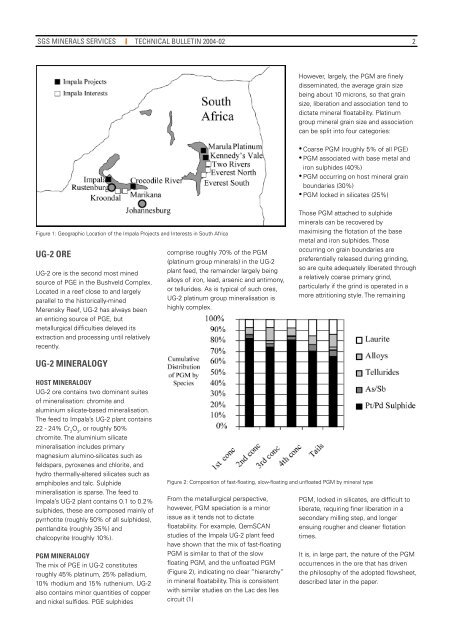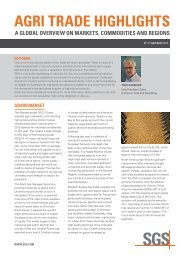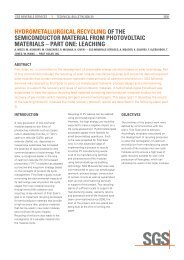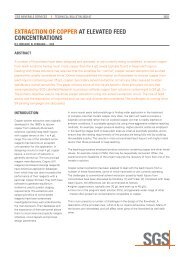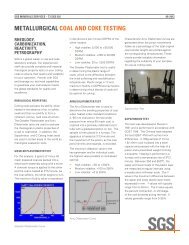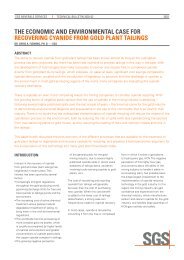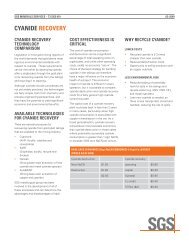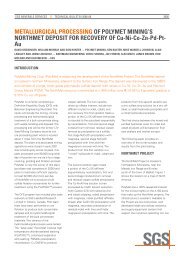pgm ore processing at impalals ug-2 concentrator in ... - SGS
pgm ore processing at impalals ug-2 concentrator in ... - SGS
pgm ore processing at impalals ug-2 concentrator in ... - SGS
Create successful ePaper yourself
Turn your PDF publications into a flip-book with our unique Google optimized e-Paper software.
<strong>SGS</strong> MINERALS SERVICES TECHNICAL BULLETIN 2004-02<br />
Figure 1: Geographic Loc<strong>at</strong>ion of the Impala Projects and Interests <strong>in</strong> South Africa<br />
UG-2 Ore<br />
UG-2 <strong>ore</strong> is the second most m<strong>in</strong>ed<br />
source of PGE <strong>in</strong> the Bushveld Complex.<br />
Loc<strong>at</strong>ed <strong>in</strong> a reef close to and largely<br />
parallel to the historically-m<strong>in</strong>ed<br />
Merensky Reef, UG-2 has always been<br />
an entic<strong>in</strong>g source of PGE, but<br />
metallurgical difficulties delayed its<br />
extraction and <strong>process<strong>in</strong>g</strong> until rel<strong>at</strong>ively<br />
recently.<br />
UG-2 M<strong>in</strong>eralOGY<br />
hOst M<strong>in</strong>eralOGY<br />
UG-2 <strong>ore</strong> conta<strong>in</strong>s two dom<strong>in</strong>ant suites<br />
of m<strong>in</strong>eralis<strong>at</strong>ion: chromite and<br />
alum<strong>in</strong>ium silic<strong>at</strong>e-based m<strong>in</strong>eralis<strong>at</strong>ion.<br />
The feed to Impala’s UG-2 plant conta<strong>in</strong>s<br />
22 - 24% Cr 2 O 3 , or ro<strong>ug</strong>hly 50%<br />
chromite. The alum<strong>in</strong>ium silic<strong>at</strong>e<br />
m<strong>in</strong>eralis<strong>at</strong>ion <strong>in</strong>cludes primary<br />
magnesium alum<strong>in</strong>o-silic<strong>at</strong>es such as<br />
feldspars, pyroxenes and chlorite, and<br />
hydro thermally-altered silic<strong>at</strong>es such as<br />
amphiboles and talc. Sulphide<br />
m<strong>in</strong>eralis<strong>at</strong>ion is sparse. The feed to<br />
Impala’s UG-2 plant conta<strong>in</strong>s 0.1 to 0.2%<br />
sulphides, these are composed ma<strong>in</strong>ly of<br />
pyrrhotite (ro<strong>ug</strong>hly 50% of all sulphides),<br />
pentlandite (ro<strong>ug</strong>hly 35%) and<br />
chalcopyrite (ro<strong>ug</strong>hly 10%).<br />
PGM M<strong>in</strong>eralOGY<br />
The mix of PGE <strong>in</strong> UG-2 constitutes<br />
ro<strong>ug</strong>hly 45% pl<strong>at</strong><strong>in</strong>um, 25% palladium,<br />
10% rhodium and 15% ruthenium. UG-2<br />
also conta<strong>in</strong>s m<strong>in</strong>or quantities of copper<br />
and nickel sulfides. PGE sulphides<br />
comprise ro<strong>ug</strong>hly 70% of the PGM<br />
(pl<strong>at</strong><strong>in</strong>um group m<strong>in</strong>erals) <strong>in</strong> the UG-2<br />
plant feed, the rema<strong>in</strong>der largely be<strong>in</strong>g<br />
alloys of iron, lead, arsenic and antimony,<br />
or tellurides. As is typical of such <strong>ore</strong>s,<br />
UG-2 pl<strong>at</strong><strong>in</strong>um group m<strong>in</strong>eralis<strong>at</strong>ion is<br />
highly complex.<br />
Figure 2: Composition of fast-flo<strong>at</strong><strong>in</strong>g, slow-flo<strong>at</strong><strong>in</strong>g and unflo<strong>at</strong>ed PGM by m<strong>in</strong>eral type<br />
From the metallurgical perspective,<br />
however, PGM speci<strong>at</strong>ion is a m<strong>in</strong>or<br />
issue as it tends not to dict<strong>at</strong>e<br />
flo<strong>at</strong>ability. For example, QemSCAN<br />
studies of the Impala UG-2 plant feed<br />
have shown th<strong>at</strong> the mix of fast-flo<strong>at</strong><strong>in</strong>g<br />
PGM is similar to th<strong>at</strong> of the slow<br />
flo<strong>at</strong><strong>in</strong>g PGM, and the unflo<strong>at</strong>ed PGM<br />
(Figure 2), <strong>in</strong>dic<strong>at</strong><strong>in</strong>g no clear “hierarchy”<br />
<strong>in</strong> m<strong>in</strong>eral flo<strong>at</strong>ability. This is consistent<br />
with similar studies on the Lac des Iles<br />
circuit (1)<br />
However, largely, the PGM are f<strong>in</strong>ely<br />
dissem<strong>in</strong><strong>at</strong>ed, the average gra<strong>in</strong> size<br />
be<strong>in</strong>g about 10 microns, so th<strong>at</strong> gra<strong>in</strong><br />
size, liber<strong>at</strong>ion and associ<strong>at</strong>ion tend to<br />
dict<strong>at</strong>e m<strong>in</strong>eral flo<strong>at</strong>ability. Pl<strong>at</strong><strong>in</strong>um<br />
group m<strong>in</strong>eral gra<strong>in</strong> size and associ<strong>at</strong>ion<br />
can be split <strong>in</strong>to four c<strong>at</strong>egories:<br />
• Coarse PGM (ro<strong>ug</strong>hly 5% of all PGE)<br />
• PGM associ<strong>at</strong>ed with base metal and<br />
iron sulphides (40%)<br />
• PGM occurr<strong>in</strong>g on host m<strong>in</strong>eral gra<strong>in</strong><br />
boundaries (30%)<br />
• PGM locked <strong>in</strong> silic<strong>at</strong>es (25%)<br />
Those PGM <strong>at</strong>tached to sulphide<br />
m<strong>in</strong>erals can be recovered by<br />
maximis<strong>in</strong>g the flot<strong>at</strong>ion of the base<br />
metal and iron sulphides. Those<br />
occurr<strong>in</strong>g on gra<strong>in</strong> boundaries are<br />
preferentially released dur<strong>in</strong>g gr<strong>in</strong>d<strong>in</strong>g,<br />
so are quite adequ<strong>at</strong>ely liber<strong>at</strong>ed thro<strong>ug</strong>h<br />
a rel<strong>at</strong>ively coarse primary gr<strong>in</strong>d,<br />
particularly if the gr<strong>in</strong>d is oper<strong>at</strong>ed <strong>in</strong> a<br />
m<strong>ore</strong> <strong>at</strong>trition<strong>in</strong>g style. The rema<strong>in</strong><strong>in</strong>g<br />
PGM, locked <strong>in</strong> silic<strong>at</strong>es, are difficult to<br />
liber<strong>at</strong>e, requir<strong>in</strong>g f<strong>in</strong>er liber<strong>at</strong>ion <strong>in</strong> a<br />
secondary mill<strong>in</strong>g step, and longer<br />
ensu<strong>in</strong>g ro<strong>ug</strong>her and cleaner flot<strong>at</strong>ion<br />
times.<br />
2<br />
It is, <strong>in</strong> large part, the n<strong>at</strong>ure of the PGM<br />
occurrences <strong>in</strong> the <strong>ore</strong> th<strong>at</strong> has driven<br />
the philosophy of the adopted flowsheet,<br />
described l<strong>at</strong>er <strong>in</strong> the paper.


